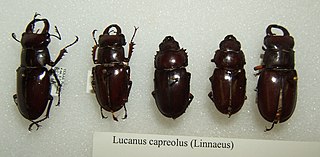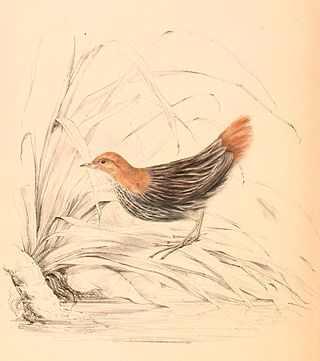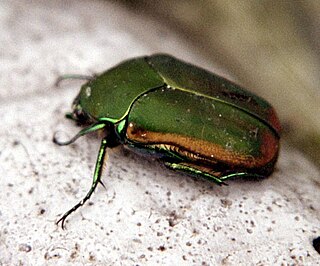
Beetles are insects that form the order Coleoptera, in the superorder Holometabola. Their front pair of wings are hardened into wing-cases, elytra, distinguishing them from most other insects. The Coleoptera, with about 400,000 described species, is the largest of all orders, constituting almost 40% of described insects and 25% of all known animal species; new species are discovered frequently, with estimates suggesting that there are between 0.9 and 2.1 million total species. However, the number of beetle species is challenged by the number of species in dipterans (flies) and hymenopterans (wasps).

The Magnoliaceae are a flowering plant family, the magnolia family, in the order Magnoliales. It consists of two genera: Magnolia and Liriodendron.

June beetle is the common name for several scarab beetles that appear around June in temperate parts of North America:
June bug or Junebug may refer to:

Cotinis nitida, commonly known as the green June beetle, June bug or June beetle, is a beetle of the family Scarabaeidae. It is found in the eastern United States and Canada, where it is most abundant in the South. It is sometimes confused with the related southwestern species figeater beetle Cotinis mutabilis, which is less destructive.

The Cotini, sometimes spelled Gotini, were a Gaulish tribe living during Roman times in the mountains approximately near the modern borders of the Czech Republic, Poland, and Slovakia.

Lucanus capreolus, the reddish-brown stag beetle or pinching beetle, is a beetle of the family Lucanidae. The specific name capreolus is derived from Latin, meaning "roe deer". The name refers to the resemblance of the mandibles to deer antlers.

The striped flufftail is a species of bird in the flufftail family Sarothruridae. It is also known as the red-tailed flufftail. The species is closely related to the Madagascar flufftail. The species has a disjunct distribution across the Afromontane of southeastern Africa, with two subspecies. The nominate subspecies S. a. affinis is found in eastern South Africa and Eswatini. S. a. antonii, named for German ornithologist Anton Reichenow, is found in eastern Zimbabwe and Mozambique, Malawi, southern Tanzania, Kenya and the south of South Sudan.

Xenocyon is an extinct group of canids, either considered a distinct genus or a subgenus of Canis. The group includes Canis (Xenocyon) africanus, Canis (Xenocyon) antonii and Canis (Xenocyon) falconeri that gave rise to Canis (Xenocyon) lycanoides. The hypercarnivorous Xenocyon is thought to be closely related and possibly ancestral to modern dhole and the African wild dog, as well as the insular Sardinian dhole.

Cotinis mutabilis, also known as the figeater beetle, is a member of the scarab beetle family. It belongs to the subfamily Cetoniinae, comprising a group of beetles commonly called flower chafers since many of them feed on pollen, nectar, or petals. Its habitat is primarily the southwestern United States and Mexico. Figeater beetles are often mistaken for green June beetles and occasionally Japanese beetles, which occur in the eastern US.

Oiceoptoma noveboracense is a member of the family Silphidae, or carrion beetles, which feed on decaying organic matter such as dead animals. Its common name is the margined carrion beetle, from the orange-red margins on the pronotum, which are helpful when identifying this species. The larva is typically light brown to red and also has vertical ridges on its thorax like the adult. This diurnal beetle can be found mainly in the spring into the fall, and it has a strong preference towards a deciduous forest habitat. The primary forensic importance of this beetle is its ability to use the succession of insect fauna to provide confirmation of postmortem intervals.
Texana denotes both the history and culture of Texas. It may also refer to:

Anton Anastas Sielava was the "Metropolitan of Kiev, Galicia and all Ruthenia" in the Ruthenian Uniate Church — a sui juris Eastern Catholic Church in full communion with the Holy See. He reigned from 1641 until his death in 1655.

Scolia dubia, also known as the two-spotted scoliid wasp or a blue-winged scoliid wasp, is a species in the family Scoliidae.
Trechus antonii is a species of ground beetle in the subfamily Trechinae. It was described by Jeannel in 1936.

Cotinis is a genus of scarab beetles in the subfamily Cetoniinae found throughout North and South America. At least two species are common pests. The genus was erected by Hermann Burmeister in 1842.
Cotinis aliena is a species of Cotinis found in the Florida Keys.
Cotinis barthelemyi is a species of scarab beetle.

Gymnetini is a tribe of fruit and flower chafers in the family Scarabaeidae. According to Catalogue of Life (2023), there are 32 genera in Gymnetini, mostly New World.

Helopeltis antonii, also known as the tea mosquito bug, are heteropterans found within the Miridae family. They have a relatively large geographical distribution and are a known pest of many agricultural “cash” crops such as cocoa, cashew, and tea. Subsequently, their impact negatively influences economic growth within the regions in which they inhabit. Thus, their impact on humans has caused them to be of great interest biologically, resulting in significant environmental implications.













